WEBINARS
-
Upcoming Webinars
-
Previous Webinars

FREE ONLINE WEBINAR | Wed, May 17, 2023 | 12:00 PM - 1:00 PM EDT
Using Biofeedback to Treat People With Developmental Trauma: Challenges and Ways to overcome them by Ainat Rogel, PhD, MSW, BCN, LICSW
The overwhelming circumstances that health professionals are experiencing during this global crisis has been and continues to be taxing on their well-being. Prolonged stress for weeks/months can trigger an acute stress disorder (ASD), which can snowball to increased risk for additional mental health disorders, such as post-traumatic stress disorder (PTSD), anxiety, and depression. It is clear: medical staff are next in the line of harm.
In light of this, we have launched a collaborative project to meet the needs of the medical staff, especially those who are not engaged in psychological or other group interventions. We want to share this project with you, in hope that you might join us or form such a group in your community.
It is imperative for this at-risk group to know how to identify their level of stress and to learn self-regulatory techniques to regulate their response when facing daily stressful conditions. Current advancements in psychophysiological monitoring and biofeedback are better adapted to the clinical setting, such as improved portability and ease-of-use. Guided by physiology-based techniques, biofeedback can introduce health professionals to activities specifically designed to build awareness and decrease the stress response, while promoting coping mechanisms that might help them to prevent further mental health issues.
Join us in this webinar, where we will talk about this collaborative project as well as present basic anatomical and physiological concepts associated with the stress response (breathing, heart rate variability, peripheral temperature, and galvanic/electrodermal skin response). These biosignals can be harnessed into both assessment tools as well as a training tools to facilitate physiological balance for stress management. Thought Technology will also be offering an ambitious deal to facilitate the project's success.
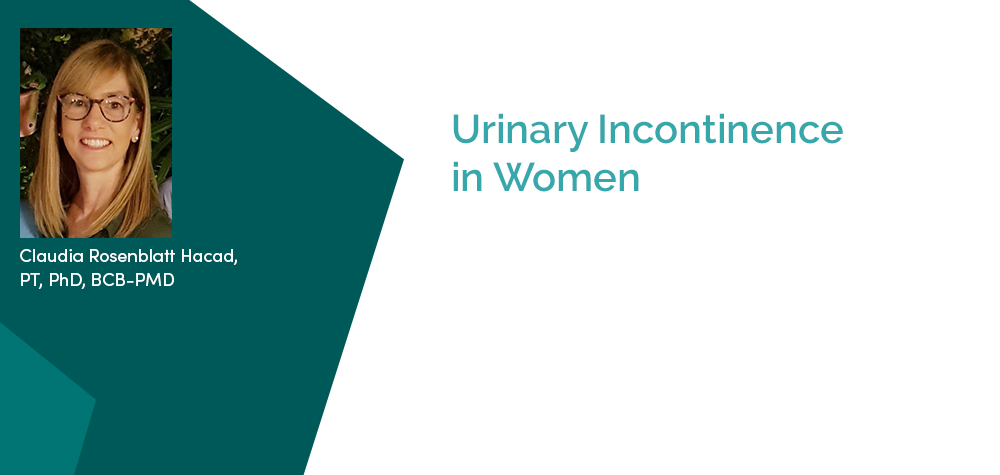
FREE ONLINE WEBINAR | Friday, June 6th | 13:00-14:00hrs EDT
Case Presentation Webinars of SEMG Biofeedback in Pelvic Floor Dysfunction: Urinary Incontinence in Women
Presenter: Claudia Rosenblatt Hacad, PT, PhD, BCB-PMD
1-hour presentation of a real case study of a woman after menopause with UI associated with genitourinary syndrome of menopause (GSM), presentation of SEMG Biofeedback record and a discussion of an article related to SEMG Biofeedback training associated with other physiotherapy techniques to improve women with incontinence associated with GSM.
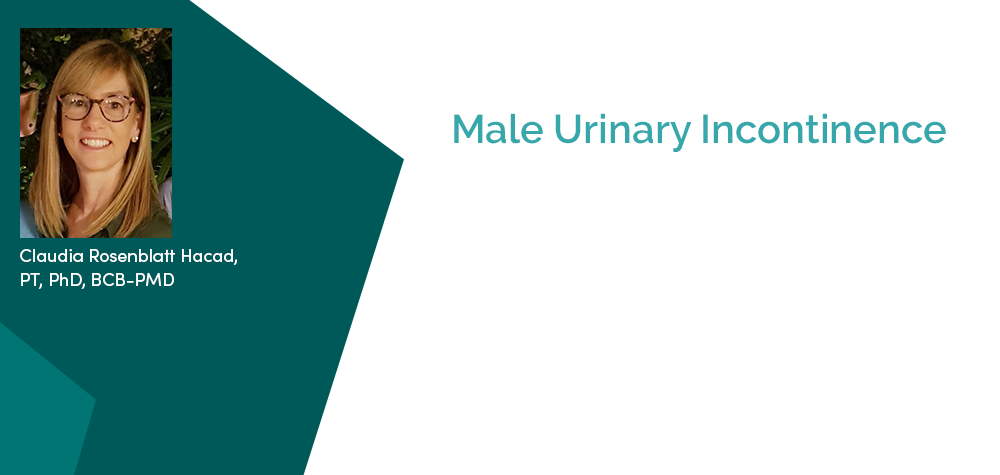
FREE ONLINE WEBINAR | Tuesday, June 13th, 2023 | 1:00-2:00pm EDT
Case Presentation Webinars of SEMG Biofeedback in Pelvic Floor Dysfunction: Male Urinary Incontinence
Presenter: Claudia Rosenblatt Hacad, PT, PhD, BCB-PMD
1-hour presentation of a real case study of a man with post prostatectomy UI associated with overactive bladder, presentation of SEMG Biofeedback record and a discussion of an article related to SEMG Biofeedback training associated with other physiotherapy techniques to improve male incontinence with overactive bladder.
FREE ONLINE WEBINAR | Monday, June 19, 2023 13:00-14:00hrs EDT
HRV Biofeedback: A basic primer
Presenter: Richard Gevirtz, Ph.D.
HRV Biofeedback (HRVB) has emerged as a powerful tool to improve flexibility in the autonomic nervous system. In this Webinar, I offer a brief introduction to the measurement of HRV and introductory protocols for HRVB touching on some applications with strong empirical support.
Presenter Bio: Dr. Richard Gevirtz is a Distinguished Professor of Psychology at the California School of Professional Psychology at Alliant International University in San Diego. He has been in involved in research and clinical work in applied psychophysiology and biofeedback for the last 30 years and was the president of the Association for Applied Psychophysiology and Biofeedback, 2006-2007. His primary research interests are in understanding the physiological and psychological mediators involved in disorders such as chronic muscle pain, fibromyalgia, and gastrointestinal pain. In this vein, he has studied applications of heart rate variability biofeedback for anxiety, pain, gastrointestinal, cardiac rehabilitation and other disorders. He is the author of many journal articles and chapters on these topics. He also maintains a part time clinical practice treating patients with anxiety and stress related disorders.
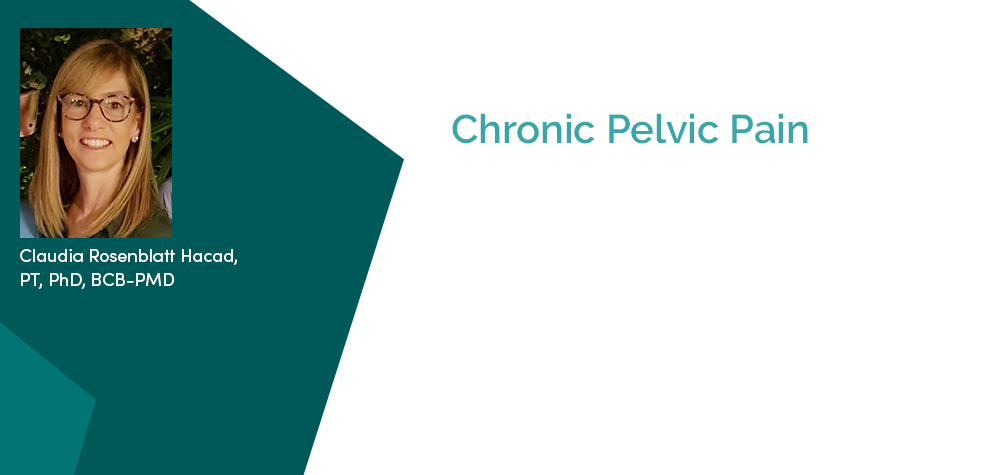
FREE ONLINE WEBINAR | Tuesday, June 20th, 2023 | 1:00-2:00pm EDT
Case Presentation Webinars of SEMG Biofeedback in Pelvic Floor Dysfunction: Chronic Pelvic Pain
Presenter: Claudia Rosenblatt Hacad, PT, PhD, BCB-PMD
1-hour presentation of a real case study of bladder pain syndrome, presentation of SEMG Biofeedback record and a discussion of an article related to SEMG Biofeedback relaxation training associated with other physiotherapy techniques to improve chronic pelvic pain and bladder pain syndrome.

FREE ONLINE WEBINAR | Tuesday, June 27th, 2023 | 1:00-2:00pm EDT
Case Presentation Webinars of SEMG Biofeedback in Pelvic Floor Dysfunction: Chronic Constipation
Presenter: Claudia Rosenblatt Hacad, PT, PhD, BCB-PMD
1-hour presentation of a real case study of puborectalis paradoxical constipation, presentation of SEMG Biofeedback record and a discussion of an article related to SEMG Biofeedback coordination training associated with other physiotherapy techniques to improve puborectalis paradoxical constipation.

FREE ONLINE WEBINAR | Wednesday, September 13th at 1-2pm EDT
Use of Heart Rate Variability (HRV) Tracking and Training in Psychotherapy by Inna Khazan, PhD, BCB Clinical Psychologist Faculty, Harvard Medical School
HRV is a strong indicator of the flexibility and resilience of our nervous system. Tracking HRV helps in assessing progress in therapy as well as estimating the client’s overall health and well-being. Moreover, attending to real-time changes during a therapy session provides valuable insights into the client's in-the-moment response, allowing the therapist to focus discussion on experiences that would have otherwise gone unnoticed. Finally, training HRV through biofeedback improves self-regulation and alleviates symptoms of psychophysiological disorders, such as anxiety, depression, trauma, chronic pain, and GI distress, further increasing the efficacy of psychotherapy. In this webinar, we will discuss easy practical ways of integrating HRV into psychotherapy, including a discussion of metrics for HRV tracking and guidelines for integrating HRV training into psychotherapy.
Presenter Bio: Inna Khazan, PhD, BCB is a faculty member at Harvard Medical School, where she teaches and supervises trainees. She is clinical psychologist specializing in health psychology and performance excellence training using biofeedback and mindfulness-based approaches. Dr. Khazan is the founder of Boston Center for Health Psychology and Biofeedback, working with clients on optimizing their health and performance. She also serves as chief science officer for Optimal HRV, a company dedicated to helping people improve their mental and physical health. Recognized as a pioneer in mindfulness-based biofeedback, Dr. Khazan is a popular speaker at national and international conferences on the topics of biofeedback and mindfulness. She has conducted biofeedback and mindfulness trainings for notable institutions in the US and abroad, including the US Navy Special Warfare, US Army Special Forces, and the Stuttgart Opera and Ballet Company. Dr. Khazan serves as president elect of the board of directors for the Association for Applied Psychophysiology and Biofeedback (AAPB), and chair elect for Biofeedback Certification International Alliance (BCIA), and is past-president of the board of directors for the Institute for Meditation and Psychotherapy (IMP). Dr. Khazan writes for Psychology today, is the author of numerous journal articles and three books, including the highly-regarded Clinical Handbook of Biofeedback: A Step-by-Step Guide to Training and Practice with Mindfulness, the popular Biofeedback and Mindfulness in Everyday Life: Practical Solutions for Improving Your Health and Performance, and the most recent The Heart(beat) of Business: Positioning Heart Rate Variability as a Competitive Advantage. She is also lead editor for the upcoming 4th edition of Evidence-Based practice in Biofeedback and Neurofeedback.
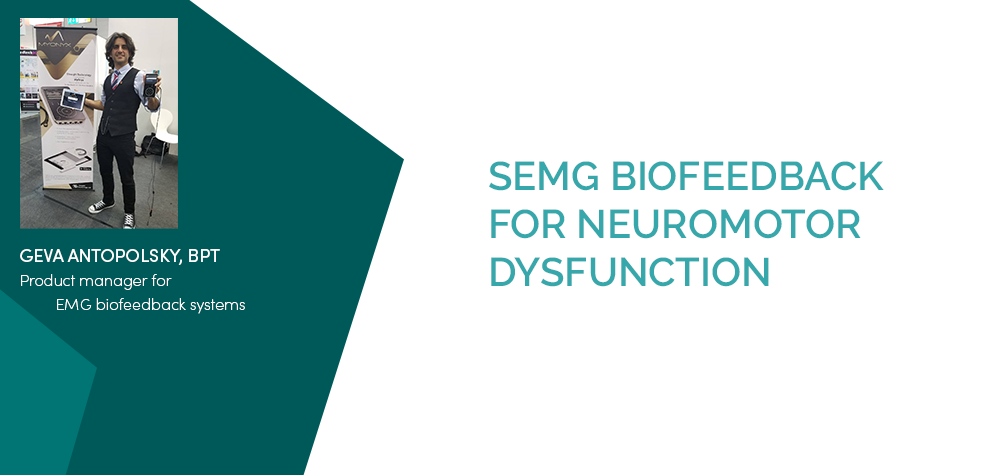
SEMG BIOFEEDBACK FOR NEUROMOTOR DYSFUNCTION by Geva Antopolsky, BPT
SEMG is a powerful tool, providing the user access to neuromuscular activation patterns otherwise invisible. In cases where neurological deficiencies alter and interrupt physical function, such as post stroke, traumatic brain injury, spinal cord injury, as well as chronic conditions, this information can be used to retrain the neuromuscular system to gain control of, and generate force in affected muscles. Since accurate, well delivered feedback is key to neuroplasticity and motor learning, having access to this information, and delivering it in the right way can be incremental to the rehabilitation process.
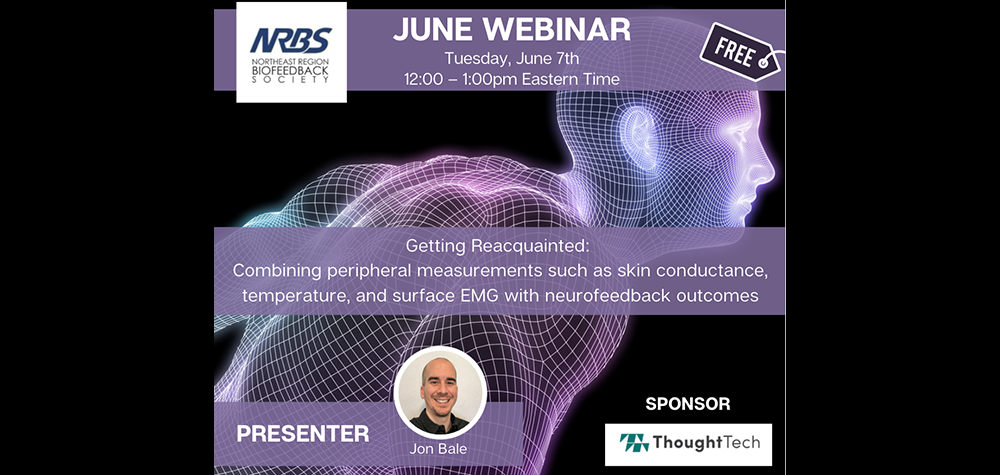
From QEEG to Neurofeedback: Bridging the Gap Between Assessment & Training for Effective Neuromodulation by Dr. David Hagedorn and Jon Bale
FREE ONLINE WEBINAR | Oct 11th, 2022 | 12:00 - 1:00PM EDT
From QEEG to Neurofeedback: Bridging the Gap Between Assessment & Training for Effective Neuromodulation by Dr. David Hagedorn and Jon Bale
Save the date, Mark your calendar. Thought Tech is proud to be hosting a collaborative free Fall webinar with our co-marketing partners Evoke Neuroscience. The eVox® System is a medical device that enables primary and specialty care physicians to assess brain function in-office and use the results to aid in making a clinical diagnosis.
Come and listen to Dr. David Hagedorn, CEO of Evoke Neuroscience and Jon Bale, Product Manager at Thought Technology as they walk you through QEEG assessment and neurofeedback training techniques: Get an in-depth look at how the eVox QEEG system can simplify and improve your client assessments. Learn how to translate the recommendations from the assessment into easy-to-implement neurofeedback and HRV biofeedback training programs. Get the tools you need to gain new insights into your clients brain function, and the knowledge to help them learn to regulate their brain wave activity. By the end of the webinar, our goal is for you to gain a better understanding of how you can use EEG, ERP, and ECG technology in your practice to improve clinical outcomes.

Getting Reacquainted: Combining peripheral measurements such as skin conductance, temperature, and surface EMG with neurofeedback outcomes with Jon Bale
After the session participants will:
- Review of clinical utility of surface electromyography (EMG), skin conductance, and temperature
- Learn exercises for each modality, that can be repeated for biofeedback sessions
- Case examples of how each modality can assist in the success of a neurofeedback session
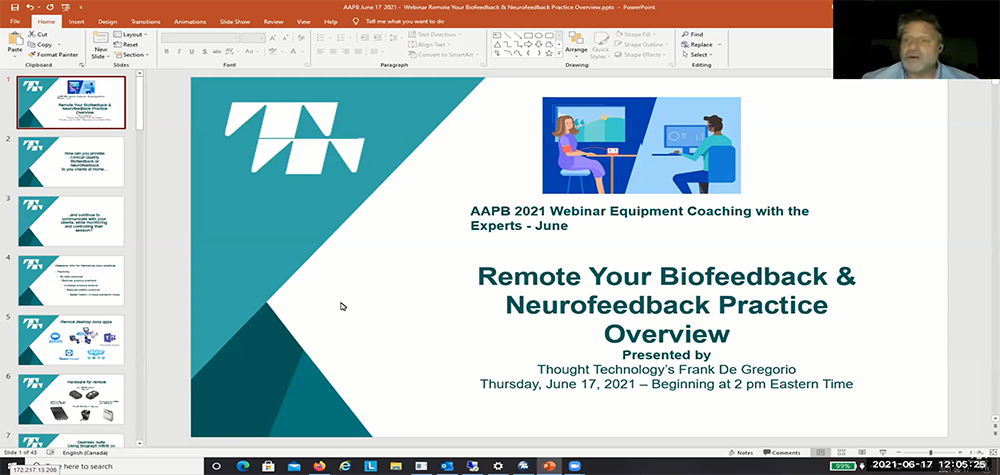
Remote Your Neurofeedback and Biofeedback Practice with Frank DeGregorio
Hardware and applications that can be used for stress-reductions and training programs administered online
Methods in growing your practice remotely:
- Assessments and reporting stress reports
- Training screens for self-regulation using biofeedback, Heart - - Rate Variability with Destress Suite & Synergy Suite
- Relations home training therapy exercises with eVu-TPS

Overview of 360 Suite
Overview of Thought Technology’s 360 Suite with Frank De Gregorio:
- Assessments for assessing and reporting stress
- Training screens for self-regulation using biofeedback, heart rate variability, and pIR Passive Infra Red sensor
- Relaxation training and home training therapy solutions with Procomp2
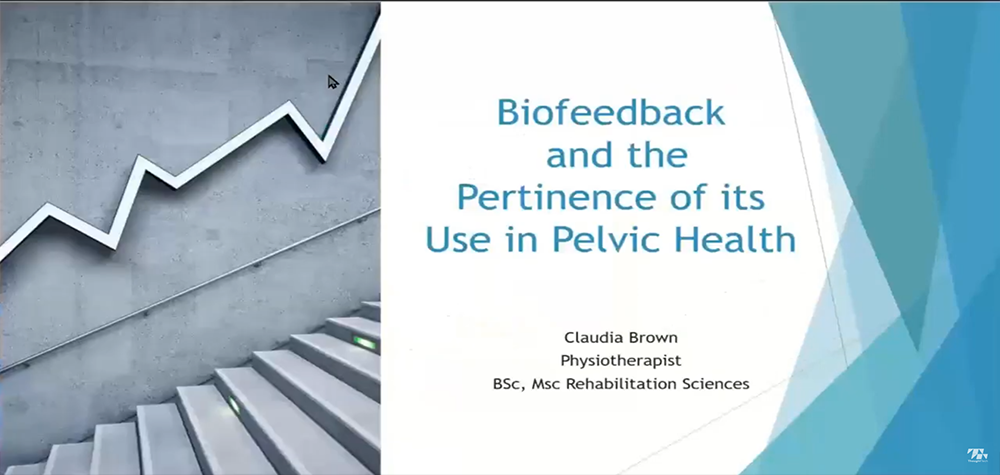
Biofeedback and the Pertinence of its Use in Pelvic Health by CLAUDIA BROWN, PT, BS | PART 1
Biofeedback is a valuable element in the toolkit of the physiotherapist working in pelvic health. As the pelvic floor muscles are relatively hidden from the patient’s view, muscle identification can be challenging, impeding the training for contraction and relaxation. Biofeedback can greatly assist in muscle identification, and, used in conjunction with other elements in the therapist’s toolkit, can complete the approach to a variety of disorders related to the pelvic floor.
This two-part online seminar will describe the nature of biofeedback and the pertinence of its use in pelvic health. Aspects related to evaluation, education, training and exercise prescription will be covered, as well as technical aspects related to the application of this modality within a treatment session. Case histories will be used to illustrate the concepts.

Biofeedback and the Pertinence of its Use in Pelvic Health by CLAUDIA BROWN, PT, BS | PART 2
Biofeedback is a valuable element in the toolkit of the physiotherapist working in pelvic health. As the pelvic floor muscles are relatively hidden from the patient’s view, muscle identification can be challenging, impeding the training for contraction and relaxation. Biofeedback can greatly assist in muscle identification, and, used in conjunction with other elements in the therapist’s toolkit, can complete the approach to a variety of disorders related to the pelvic floor.
This two-part online seminar will describe the nature of biofeedback and the pertinence of its use in pelvic health. Aspects related to evaluation, education, training and exercise prescription will be covered, as well as technical aspects related to the application of this modality within a treatment session. Case histories will be used to illustrate the concepts.
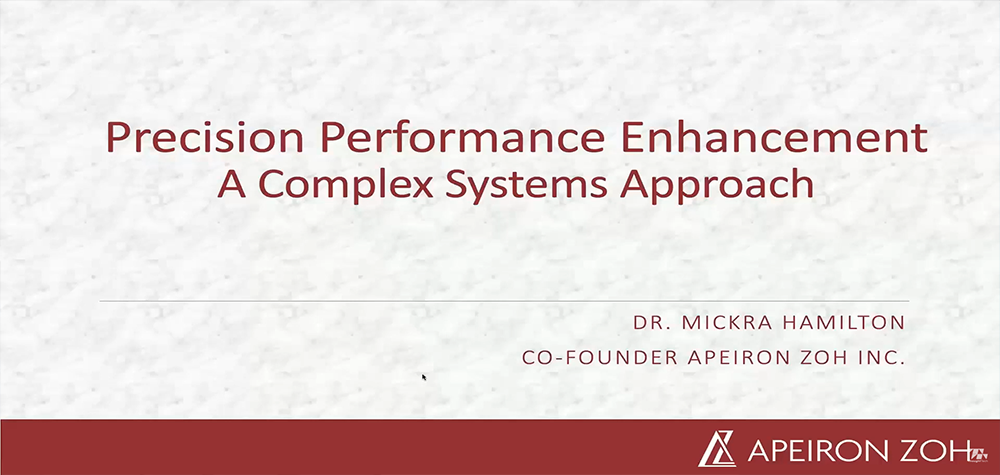
Precision Performance Enhancement: A Complex Systems Approach with Psychophysiology; Micka Hamilton
In this presentation, Dr. Mickra Hamilton shares a precision complex systems approach to optimizing and enhancing human performance. This will include the mention of performance biofeedback strategies combined with CO2 optimization, neuro and neuromuscular modulation, genetics/epigenetic expression. You will learn how these advanced strategies are being used in clinical application and review relevant case studies. Additionally, you will understand the potential for rapid transformation and enhanced performance when addressing the entire human system.
Dr. Mickra Hamilton is Co-Founder of Apeiron Zoh Corporation, a Precision Performance Ecosystem that Curates Limitless Expression. A Systems Designer and creative disruptor in the field of Precision Human Performance she informs a new paradigm of what is possible for human flourishing and purposeful evolution. Dr. Hamilton speaks internationally on the focus areas of the epigenetics of the human system and environment, breathing science, conscious leadership and peak psychophysiological performance.
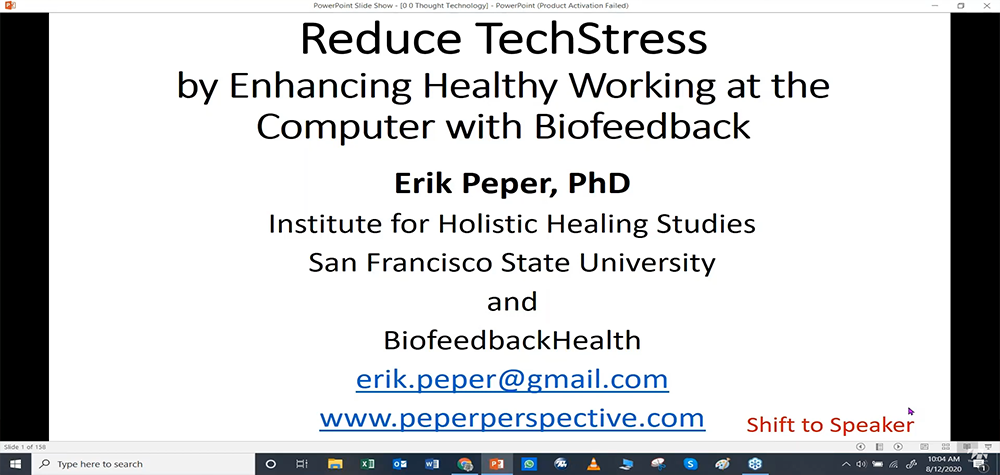
Reduce Tech Stress by Enhancing Healthy Working at the Computer with Biofeedback; Erik Peper Ph.D.
This webinar recording is part of the on-going presentation series offered by Thought Technology on biofeedback applications. Visit out website to learn more about physiological evaluation tools, whether measuring muscle tension or multiple biometrics simultanesouly
The recent shift in work might have you sitting more at the computer, trapped in seemingly never-ending series of online meetings/Zoom calls, or just looking at a screen without the opportune breaks. Do any of these symptoms sound familiar to your work day?: fatigue, eyestrain, back pain, neck and shoulder discomfort, exhaustion, distraction, stress, negative mood, depression, or insomnia?
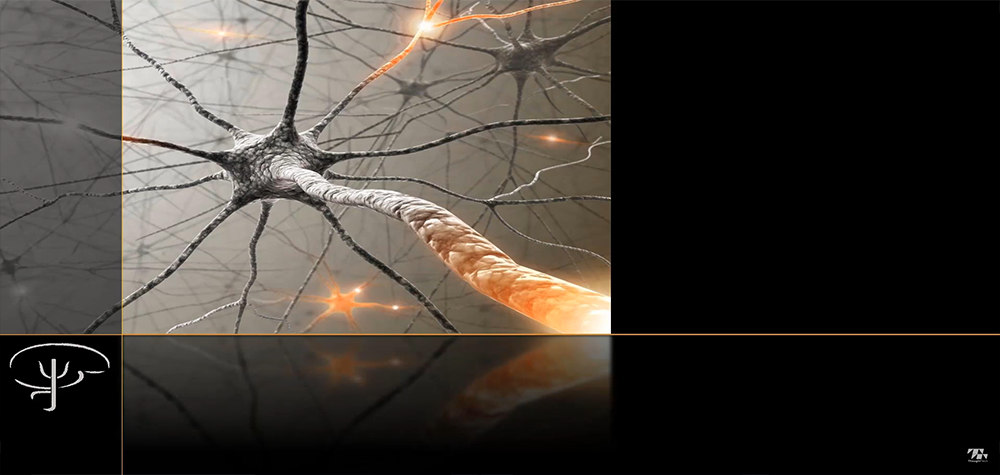
Psychophysiology's New Reality: Medical Paradigm Shift in a Covid-19 World Webinar
This webinar aims to discuss and give an overview how applied psychophysiology fits into this new reality, and how it can intervene in both classic and new pathologies in the psychological and medical fields, either as a main therapy or contributing to other interventions of an interdisciplinary nature, and how the technology we use allows us to work in a safe environment for everyone without sacrificing the humanity, clinical quality and therapeutic efficacy required to have the best possible results following the highest ethical scientific standards.

PART 1: Urinary Incontinence
Presenting 5, two-hour webinars Tuesdays, beginning Sept.29, 2020 from 13:00 – 15:00 hrs EDT/EST
Webinar is accredited by BCIA to provide 2 hours of accredited continuing education toward BCIA recertification
Voiding dysfunction and pelvic floor disorders in men and women cause a high impact in their social, labor, sexual and general quality of life.
According to International Continence Society(ICS), American Urological Association (AUA) and European Association of Urology (EAU) Guidelines, SEMG Biofeedback is recommended to be included as a conservative treatment for subjects with stress urinary incontinence (SUI), fecal incontinence (FI), overactive bladder (OAB) and chronic pelvic pain (CPP) and sexual dysfunction (SD) and also recommended as first line conservative treatment for subjects with puborectalis paradoxical constipation(PPC).
As an assessment tool, SEMG signal can give us insight on the condition and function of the neuromuscular system and help pinpoint deficits.
As a training tool, SEMG is a powerful tool, allowing the user to gain awareness of their own voluntary contraction and relaxation efforts and regain control of these functions.
These webinars will provide theoretical updates and practical skills-based evidence on the SEMG Biofeedback Assessment and Treatment of Incontinence, CPP and Sexuality in men and women.

PART 2: Post Prostatectomy Urinary Incontinence
Presenting 5, two-hour webinars Tuesdays, beginning Sept.29, 2020 from 13:00 – 15:00 hrs EDT/EST
Voiding dysfunction and pelvic floor disorders in men and women cause a high impact in their social, labor, sexual and general quality of life.
According to International Continence Society(ICS), American Urological Association (AUA) and European Association of Urology (EAU) Guidelines, SEMG Biofeedback is recommended to be included as a conservative treatment for subjects with stress urinary incontinence (SUI), fecal incontinence (FI), overactive bladder (OAB) and chronic pelvic pain (CPP) and sexual dysfunction (SD) and also recommended as first line conservative treatment for subjects with puborectalis paradoxical constipation(PPC).
As an assessment tool, SEMG signal can give us insight on the condition and function of the neuromuscular system and help pinpoint deficits.
As a training tool, SEMG is a powerful tool, allowing the user to gain awareness of their own voluntary contraction and relaxation efforts and regain control of these functions.
These webinars will provide theoretical updates and practical skills-based evidence on the SEMG Biofeedback Assessment and Treatment of Incontinence, CPP and Sexuality in men and women.

PART 3: Sexual Dysfunction
Presenting 5, two-hour webinars Tuesdays, beginning Sept.29, 2020 from 13:00 – 15:00 hrs EDT/EST
Voiding dysfunction and pelvic floor disorders in men and women cause a high impact in their social, labor, sexual and general quality of life.
According to International Continence Society(ICS), American Urological Association (AUA) and European Association of Urology (EAU) Guidelines, SEMG Biofeedback is recommended to be included as a conservative treatment for subjects with stress urinary incontinence (SUI), fecal incontinence (FI), overactive bladder (OAB) and chronic pelvic pain (CPP) and sexual dysfunction (SD) and also recommended as first line conservative treatment for subjects with puborectalis paradoxical constipation(PPC).
As an assessment tool, SEMG signal can give us insight on the condition and function of the neuromuscular system and help pinpoint deficits.
As a training tool, SEMG is a powerful tool, allowing the user to gain awareness of their own voluntary contraction and relaxation efforts and regain control of these functions.
These webinars will provide theoretical updates and practical skills-based evidence on the SEMG Biofeedback Assessment and Treatment of Incontinence, CPP and Sexuality in men and women.

PART 4: Chronic Pelvic Pain
Presenting 5, two-hour webinars Tuesdays, beginning Sept.29, 2020 from 13:00 – 15:00 hrs EDT/EST
Voiding dysfunction and pelvic floor disorders in men and women cause a high impact in their social, labor, sexual and general quality of life.
According to International Continence Society(ICS), American Urological Association (AUA) and European Association of Urology (EAU) Guidelines, SEMG Biofeedback is recommended to be included as a conservative treatment for subjects with stress urinary incontinence (SUI), fecal incontinence (FI), overactive bladder (OAB) and chronic pelvic pain (CPP) and sexual dysfunction (SD) and also recommended as first line conservative treatment for subjects with puborectalis paradoxical constipation(PPC).
As an assessment tool, SEMG signal can give us insight on the condition and function of the neuromuscular system and help pinpoint deficits.
As a training tool, SEMG is a powerful tool, allowing the user to gain awareness of their own voluntary contraction and relaxation efforts and regain control of these functions.
These webinars will provide theoretical updates and practical skills-based evidence on the SEMG Biofeedback Assessment and Treatment of Incontinence, CPP and Sexuality in men and women.

PART 5: Constipation and Fecal Incontinence7
Presenting 5, two-hour webinars Tuesdays, beginning Sept.29, 2020 from 13:00 – 15:00 hrs EDT/EST
Voiding dysfunction and pelvic floor disorders in men and women cause a high impact in their social, labor, sexual and general quality of life.
According to International Continence Society(ICS), American Urological Association (AUA) and European Association of Urology (EAU) Guidelines, SEMG Biofeedback is recommended to be included as a conservative treatment for subjects with stress urinary incontinence (SUI), fecal incontinence (FI), overactive bladder (OAB) and chronic pelvic pain (CPP) and sexual dysfunction (SD) and also recommended as first line conservative treatment for subjects with puborectalis paradoxical constipation(PPC).
As an assessment tool, SEMG signal can give us insight on the condition and function of the neuromuscular system and help pinpoint deficits.
As a training tool, SEMG is a powerful tool, allowing the user to gain awareness of their own voluntary contraction and relaxation efforts and regain control of these functions.
These webinars will provide theoretical updates and practical skills-based evidence on the SEMG Biofeedback Assessment and Treatment of Incontinence, CPP and Sexuality in men and women.
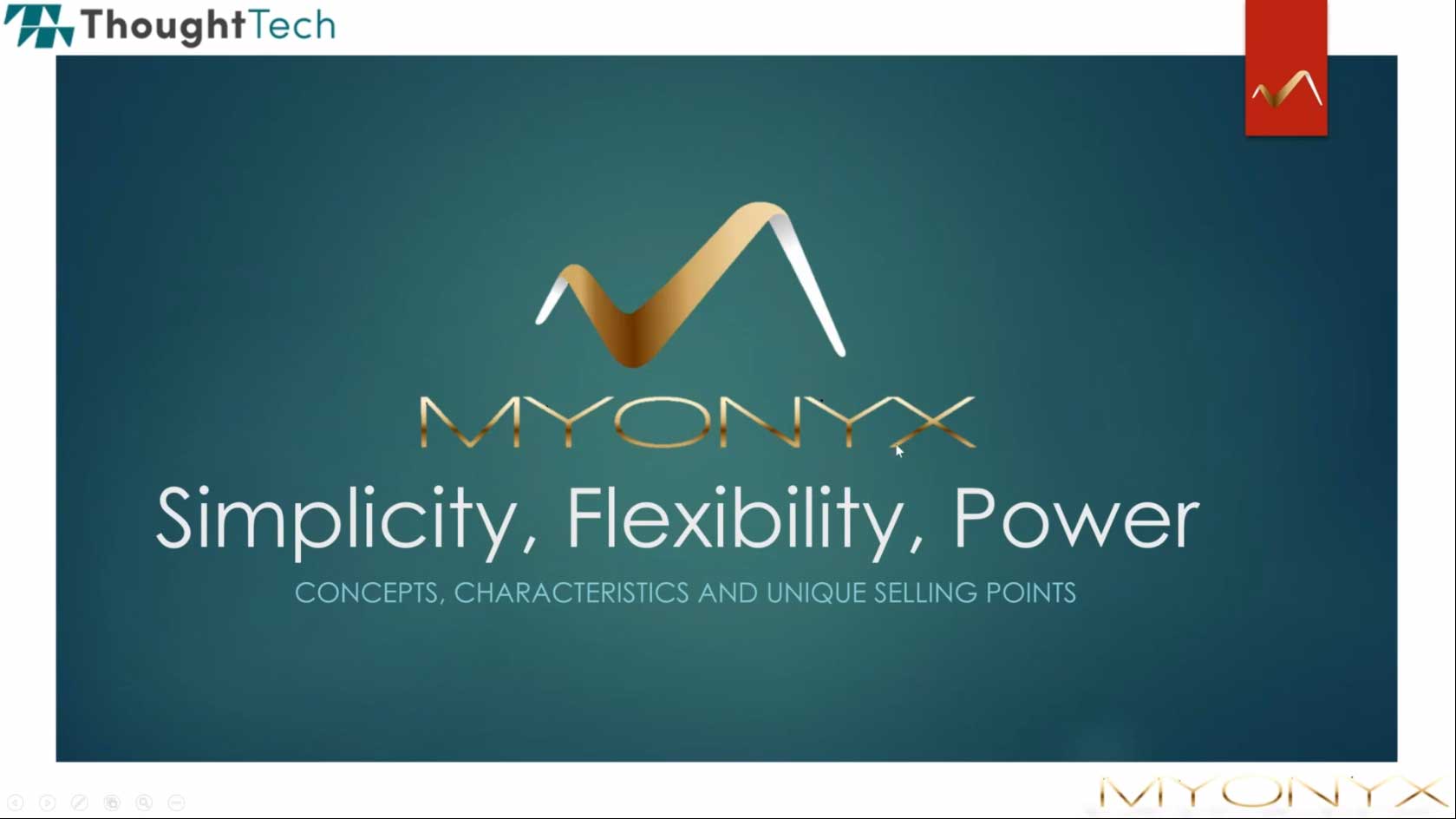
PRODUCTION INTRODUCTION MYONYX WEBINAR
Introduction to the MyOnyx device. A portable, rechargeable device for surface EMG biofeedback and electrostimulation which offers three functionality modes: standalone, remote control with an Android device and PC controlled with Windows software.
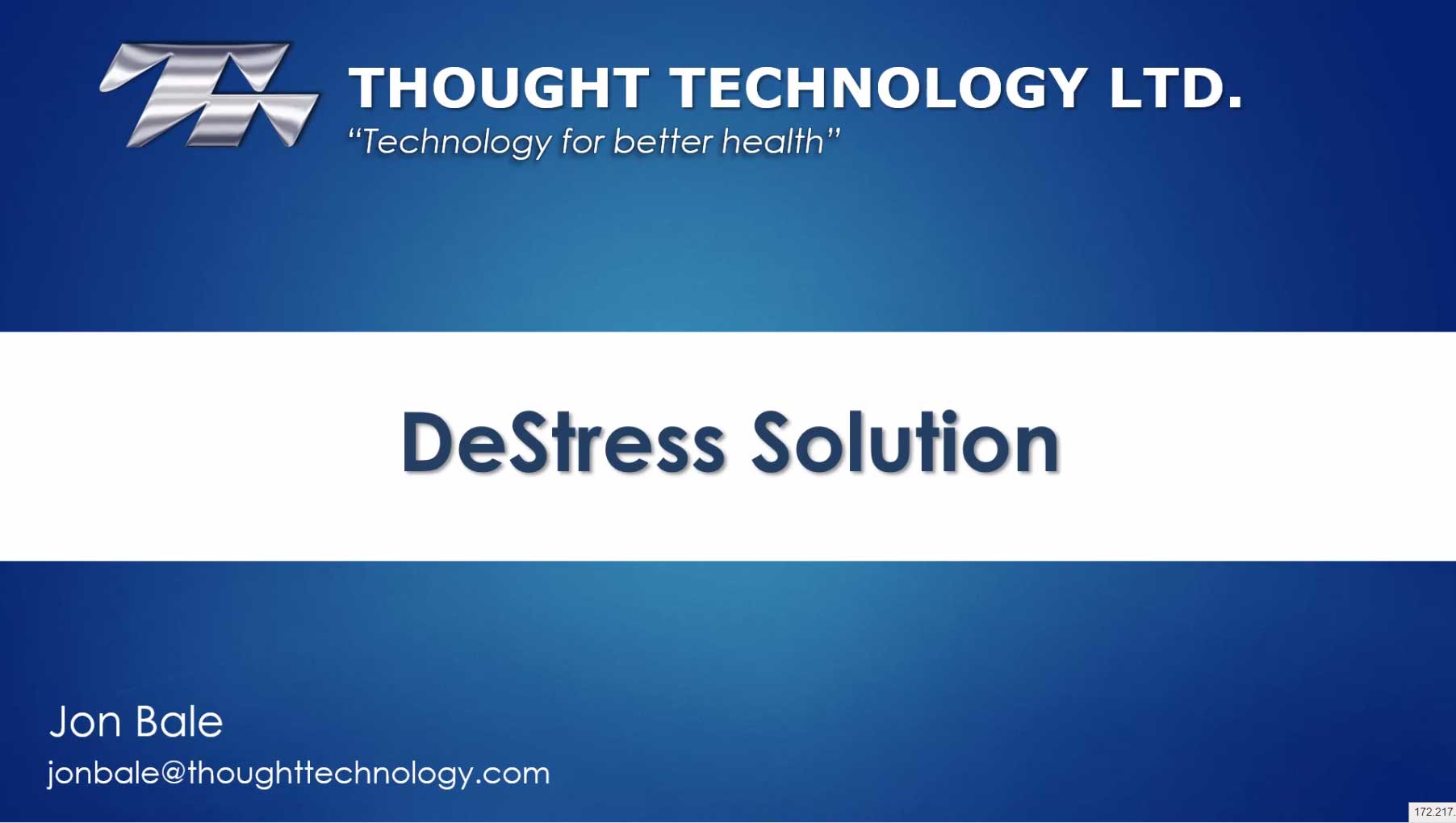
DESTRESS SOLUTION: BIOFEEDBACK WITH THE TPS SENSOR AND BIOGRAPH SOFTWARE
You made your voices heard, and we have listened in the creation of the DeStress Solution:
• You want an easy-to-use wireless sensor that pairs with the BioGraph software.
• You want self-interpreted evaluation results.
• You want clinical utility with options for games and game-like sessions.
• You want an all-in-one possibility for measurement of arousal, temperature, heart rate variability, and even respiration.Watch this 45 minute recording to see how this tool can do all the above and more for quantifying the physiology of stress, teaching relaxation, and enhancing resilience.
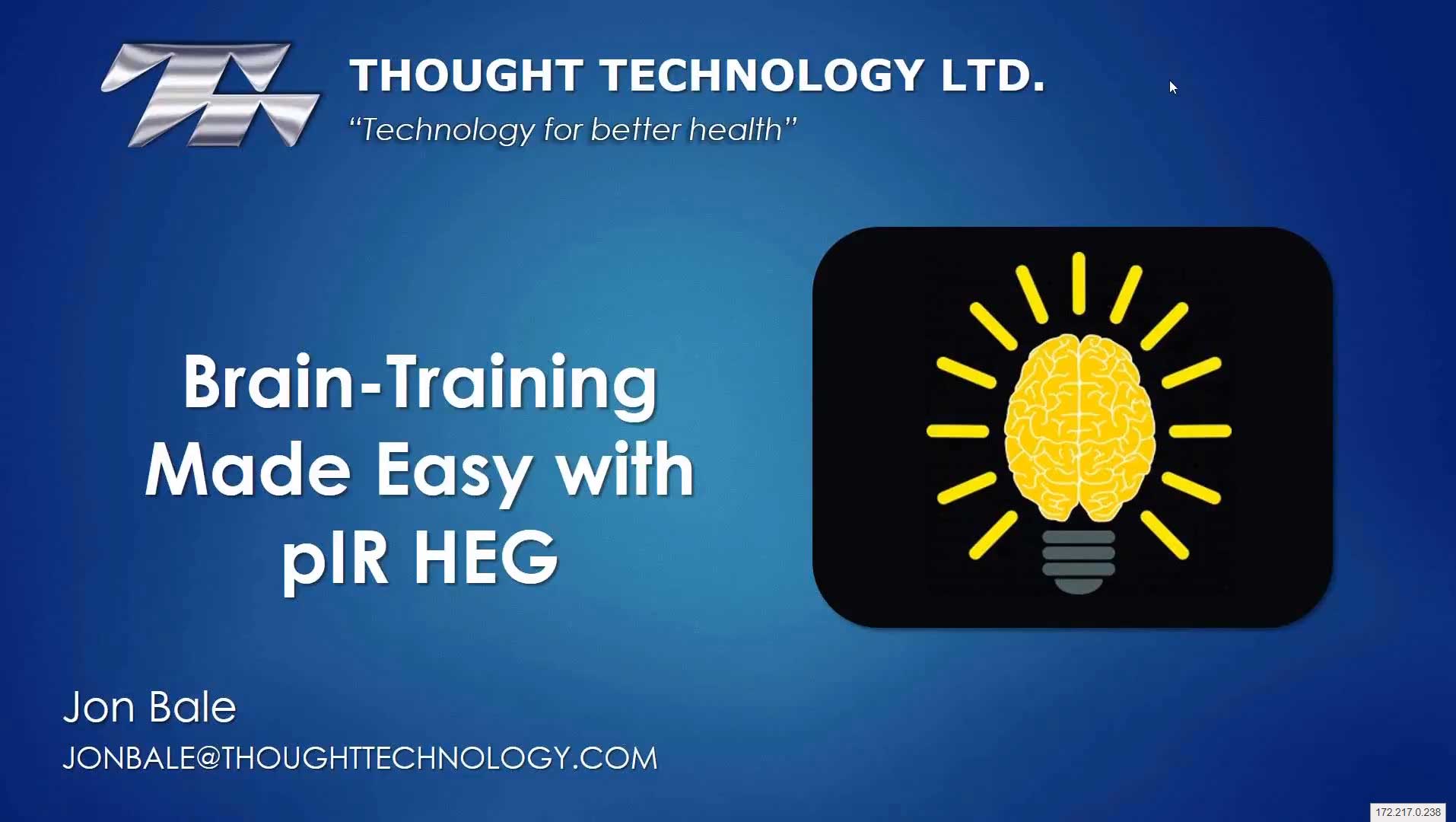
BRAIN TRAINING MADE EASY WITH PIR HEG
Are you to type of clinician that wishes they could add the benefits of neurofeedback to your clinical methods, but just aren’t ready for the complexities of the data? A solution exists for you that matches the simplicity of training physiology with biofeedback: passive infrared hemoencephalography (pIR HEG). It’s an indirect measurement of cerebral blood flow that is easy to apply, simple for a client to understand, and rapidly engaging.

NEUROFEEDBACK TIPS FOR STRUCTURING EEG SESSIONS
Are you getting started with neurofeedback, or planning on soon joining this advancing field? If so, this webinar recording is meant to help you avoid some potential trial-and-error that beginners otherwise discover on their own. Included topics of discussion were the general approach to assess and train brainwaves, common pitfalls novice clinicians need to avoid, and tips for setting up and maintaining a smooth-running session. Thought Technology’s EEG Suite was used as a point of reference.
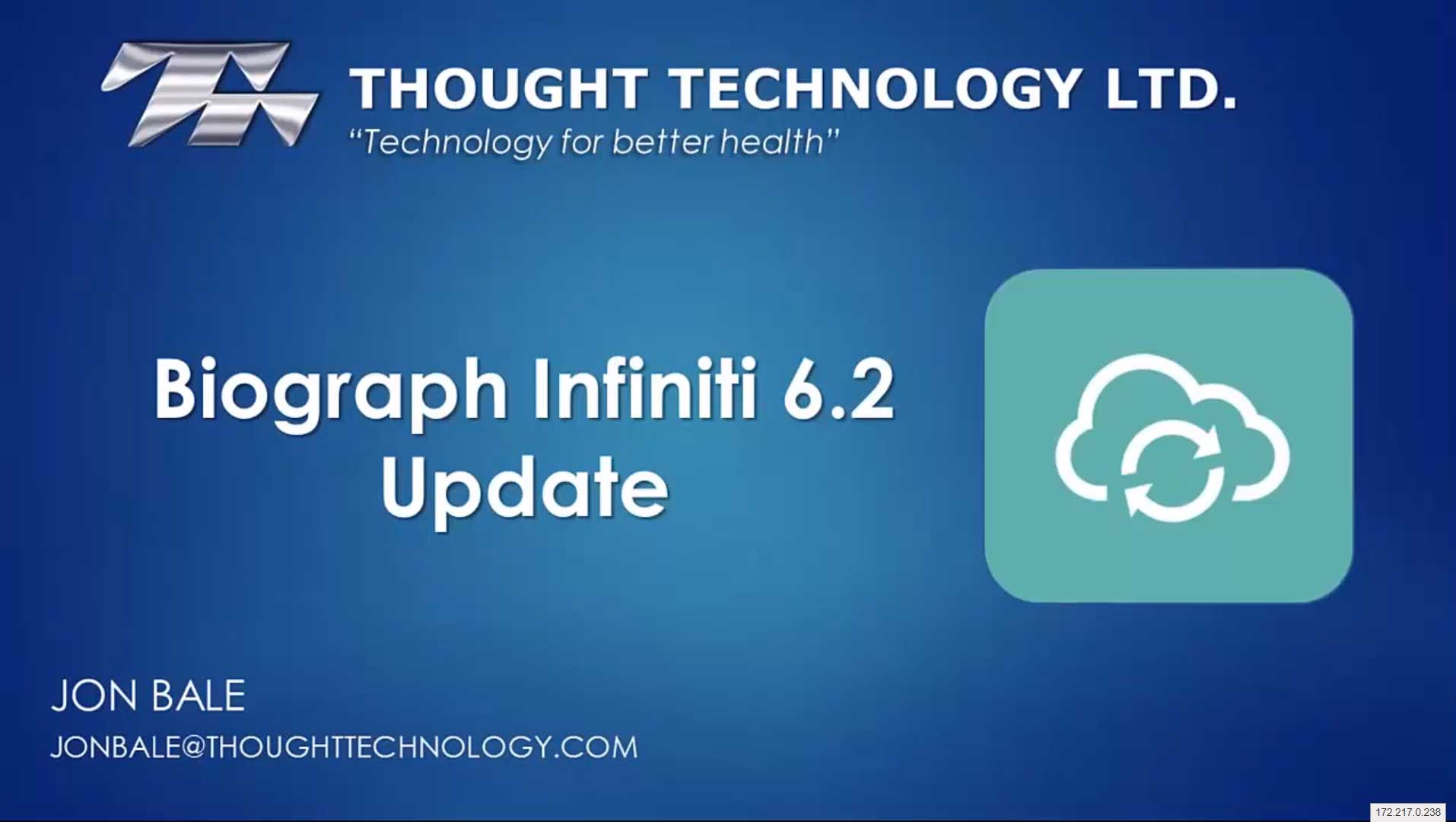
BIOGRAPH 6.2 SOFTWARE UPDATE
Thought Technology sales exec Jon Bale sits down and goes through the latest changes you will find in V6.2 of Biograph Infiniti.

HOW TO BUILD A QUICK START FAVORITE
Ever wanted to add your own unique selection of sessions to the Biograph Infiniti Quick Start menu, but never sure how to do it? Follow this short video that will show you how to customize your own Quick Start Favorites.
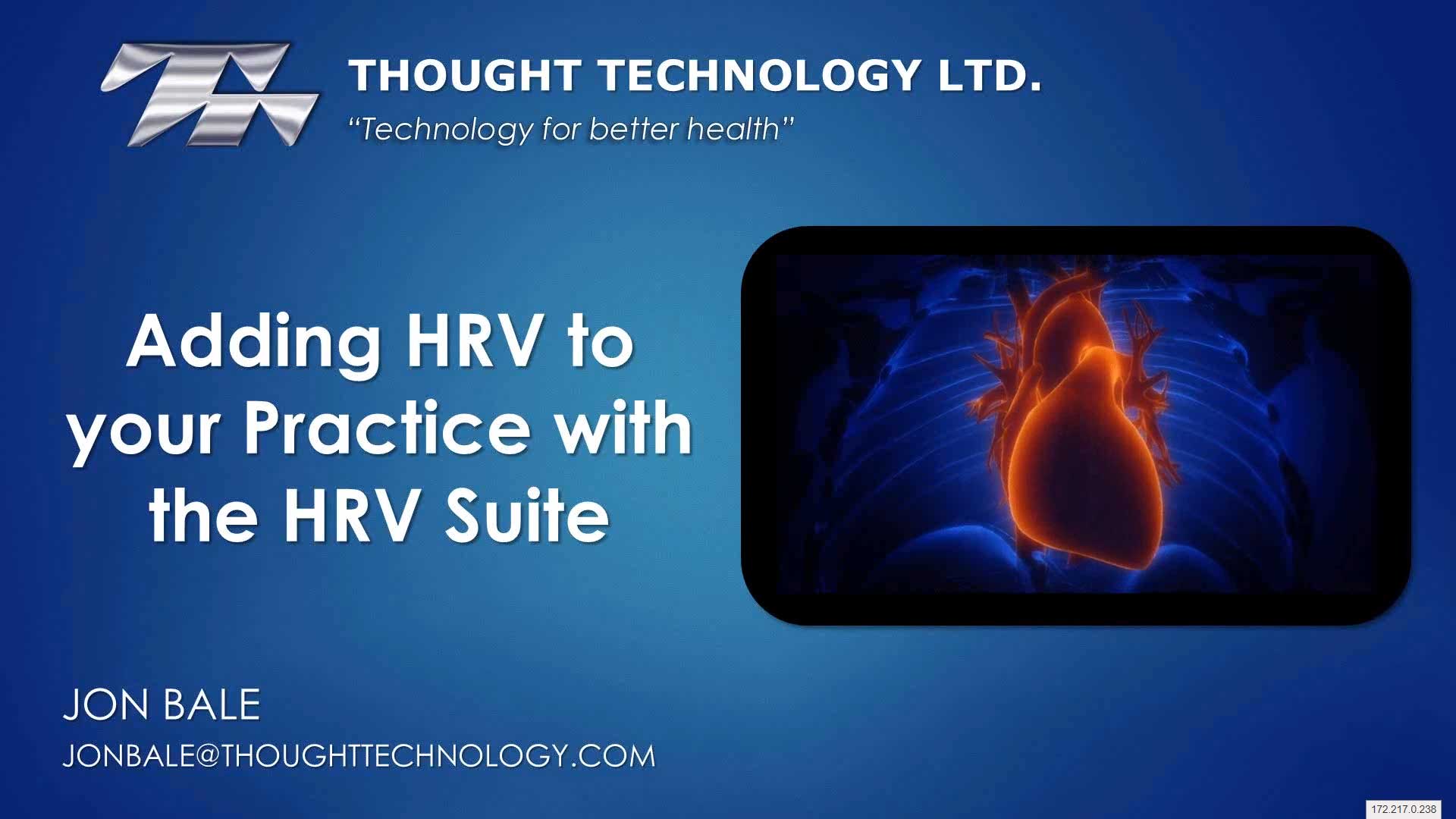
ADDING HRV INTO YOUR PRACTICE USING THE HRV SUITE
Published research has never been clearer on the significance and benefits of HRV training for a wide variety of conditions, including stress, anxiety, depression, IBS, performance enhancement, and concussions. Although it can be a challenge to know where to start, integrating this modality doesn't have to be difficult. With the HRV Suite, the entire process from assessment to training has been streamlined to be as straight-forward as can be. In this live webinar recording, Jon Bale guides viewers through the process of running a heart rate variability assessment, generating a report, and running a training session. He also touches on the topics of resonance frequency assessment and guided relaxation through paced breathing.
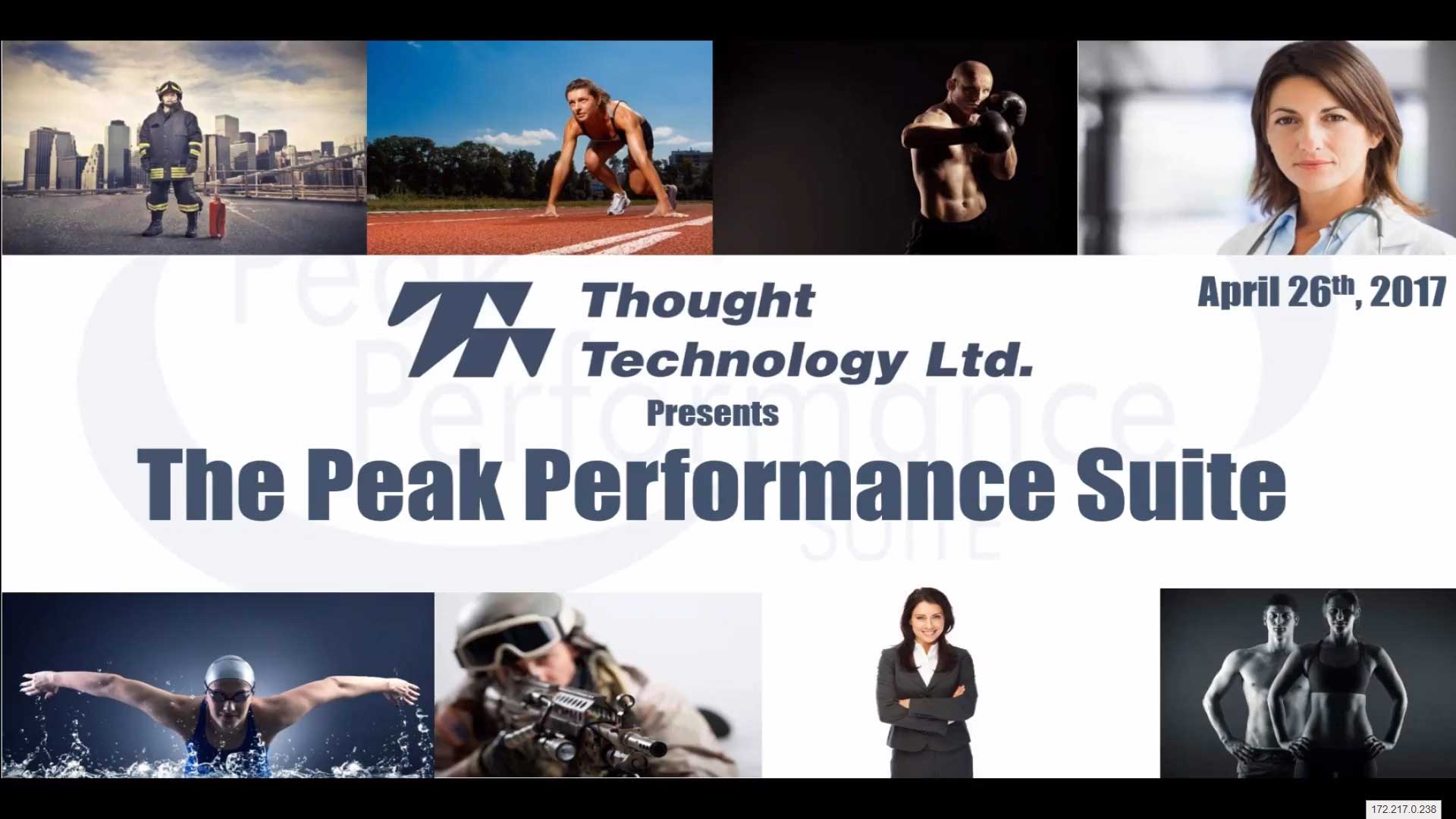
INTRODUCTION TO THE PEAK PERFORMANCE SUITE
Coaches, sport psychologists, clinicians and health practitioners working in the field of peak performance will be excited by the release of Thought Technology’s newest application: the Peak Performance Suite. Developed in collaboration with Dr. Pierre Beauchamp, the suite is the accumulation of more than 35 years of high performance training applied in a variety of performance environments.
Join Lucas Borgo for this 1-hour webinar, where he explores the software suite’s training tools to give your performers the skills they need when it matters most, show the different assessments and reports that will act as a guide for training, and answer any questions about the new peak performance equipment bundles.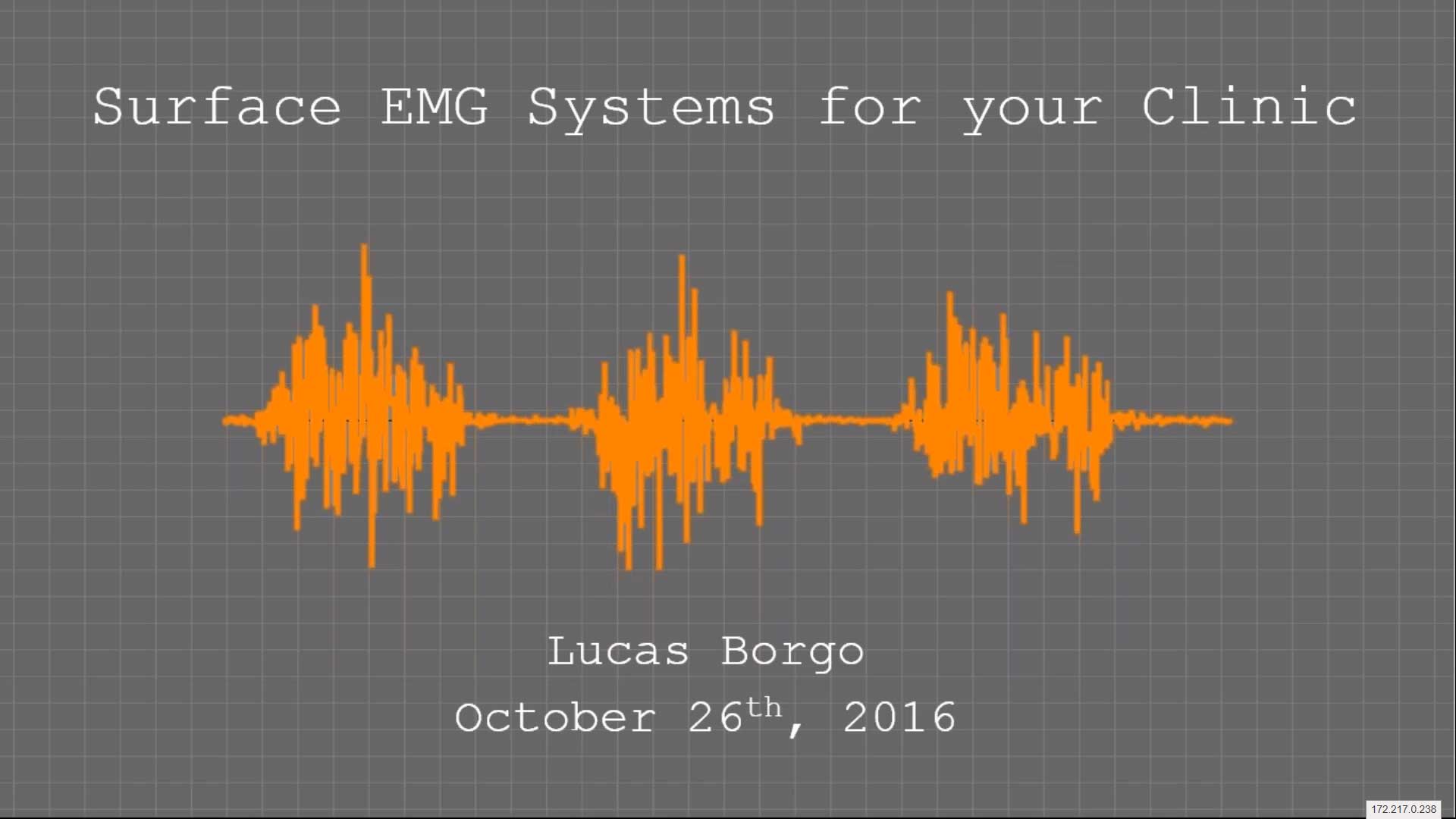
SURFACE EMG SYSTEMS FOR YOUR CLINIC
Traditional rehabilitation programs can be enhanced with the integration of surface electromyography. Using sEMG biofeedback in rehabilitation can increase muscle control, regain full muscle functionality, and decrease time to full recovery.
Lucas Borgo presents a 1 hour in-depth look at Thought Technology’s EMG product offerings. Join him as he breaks down the capabilities of a research-grade EMG system, how they can be integrated into your clinic, and how they can enhance your clients’ successes.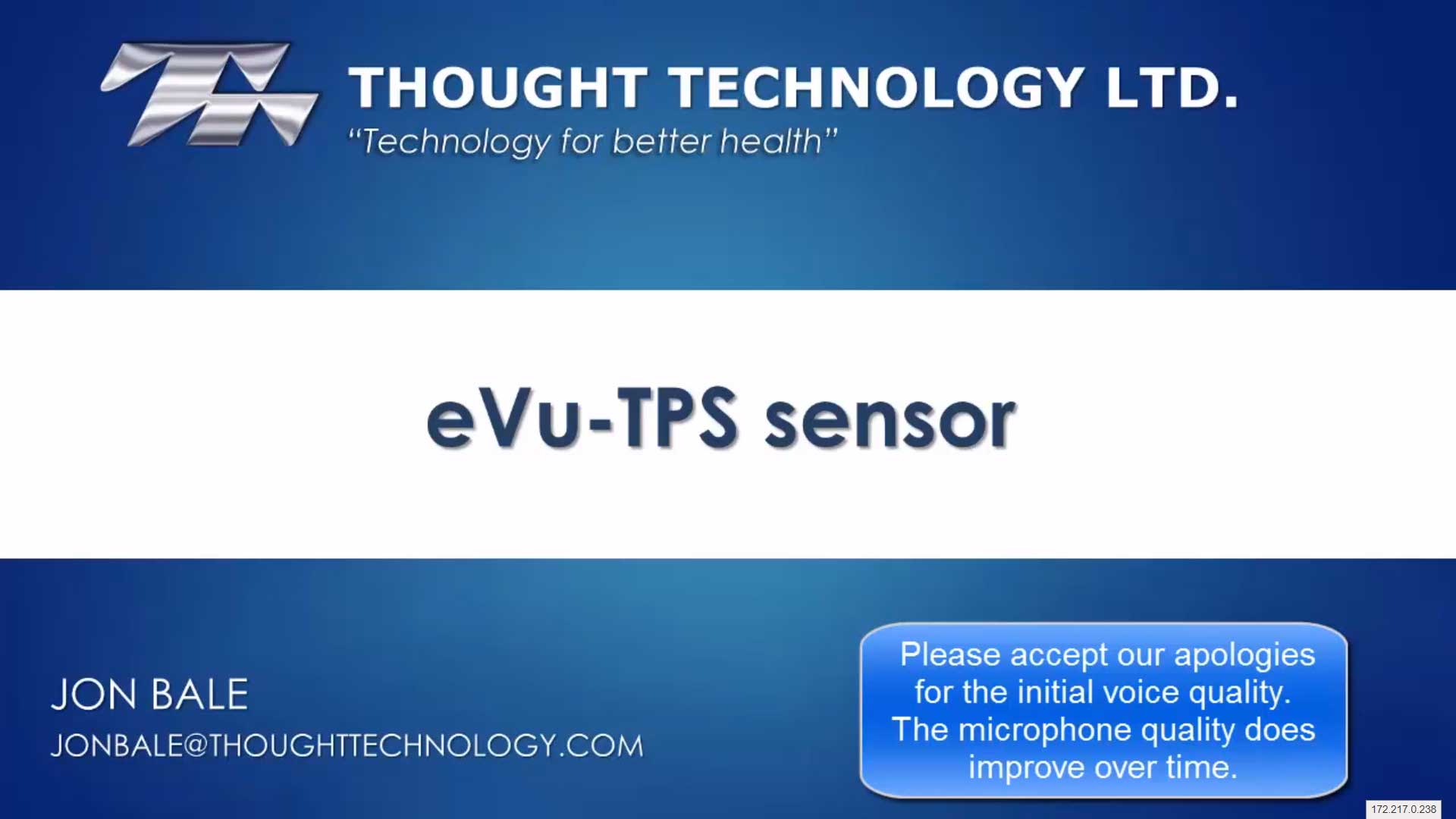
EVU TPS SENSOR LAUNCH: THE WIRELESS TRIPLE PHYSIOLOGY SENSOR
eVu TPS Sensor Launch: The Wireless Triple Physiology Sensor for Smartphones and Tablets.
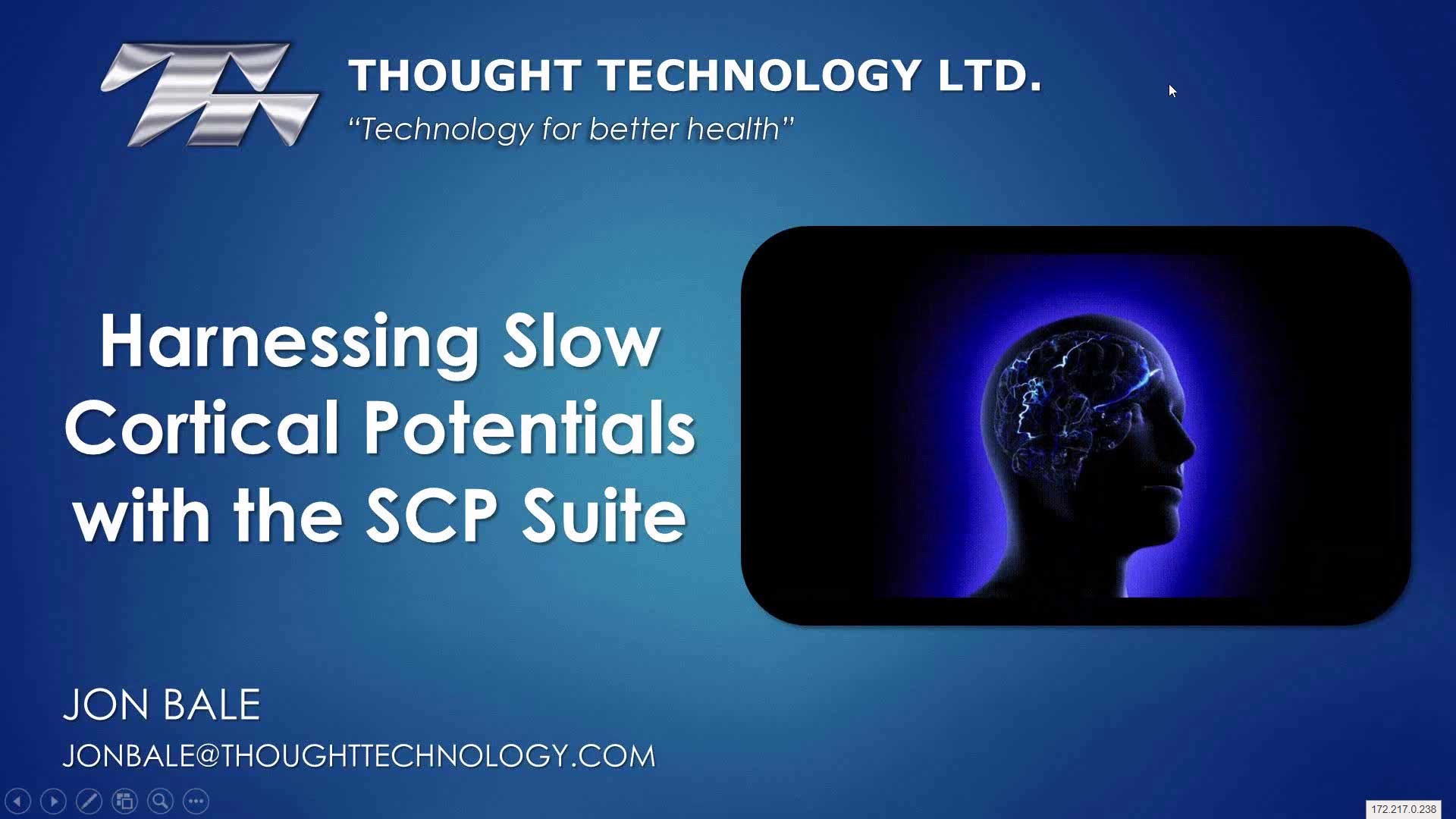
HARNESSING SLOW CORTICAL POTENTIALS WITH THE SCP SUITE
Learn how Thought Technology’s SCP Suite combines pioneering EEG research and decades of clinical experience into a simple EEG package for training slow cortical potentials in your clinical practice.

MASTERING EEG ELECTRODE APPLICATION FOR A GOOD IMPEDANCE
New to neurofeedback and applying EEG electrodes to an individual’s head? Watch this webinar recording to learn the tips and tricks of how to apply electrodes to ensure a good impedance.
